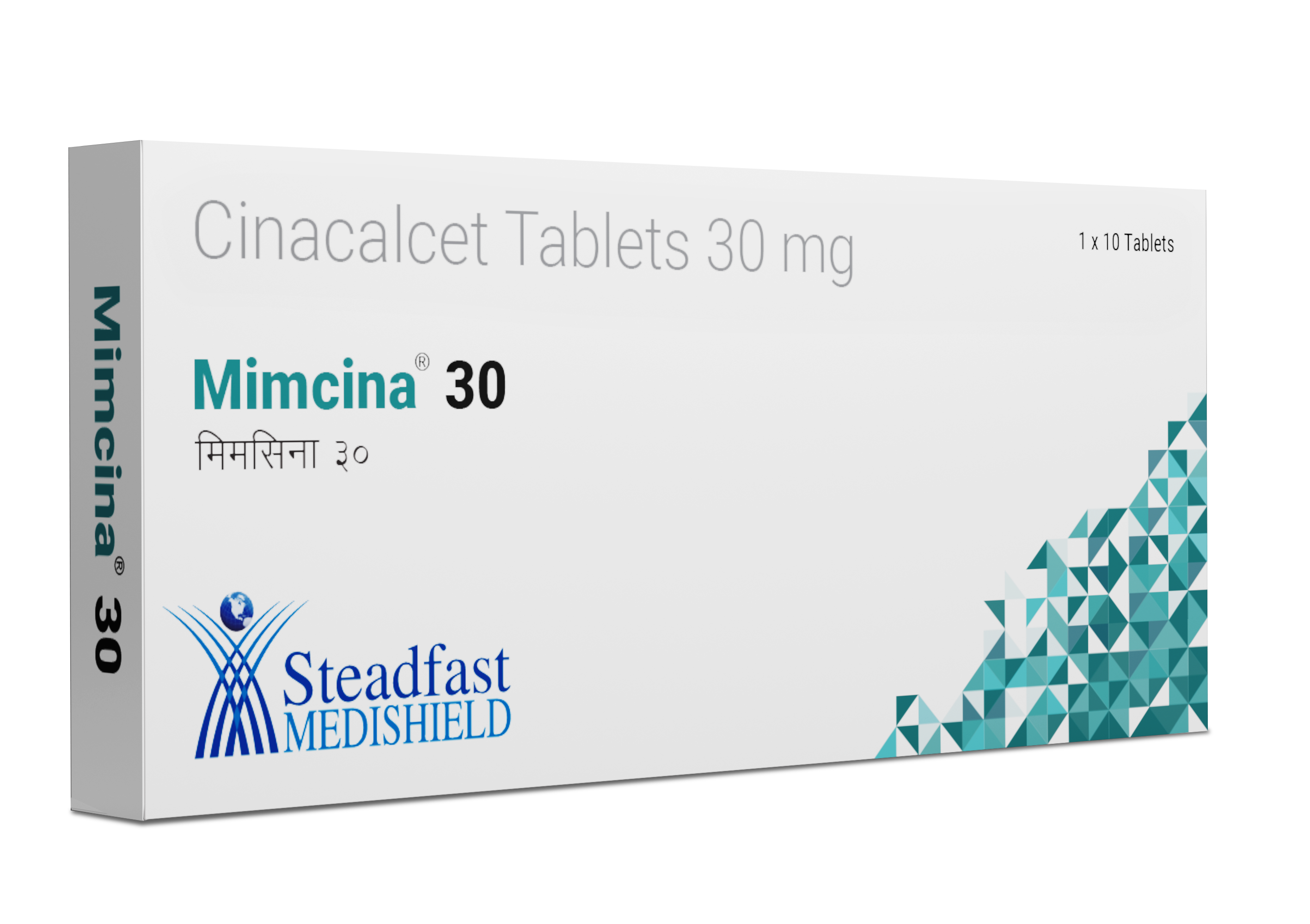DESCRIPTION:
Mimcina is positive modulator for Calcium sensing receptor that is indicated for secondary hyperparathyroidism in adult patients with chronic kidney disease.
COMPOSITION:
Each film coated tablet contains:
Cinacalcet Hydrochloride …. 30 mg
Dosage Form: Tablet
PHARMACOLOGY
Mechanism of Action
sHPT in patients with CKD is a progressive disease, related with increase in the levels of PTH and imbalance in calcium and phosphorus metabolism. The goals of treatment of sHPT are to lower the levels of PTH, calcium, and phosphorus in the blood in for preventing progressive bone disease and normalise the disordered mineral metabolism. The calcium-sensing receptor on the surface of the chief cell of the parathyroid gland is the principal regulator of PTH synthesis and secretion. Mimcina directly lowers PTH levels by increasing the sensitivity of the calcium-sensing receptor to extracellular calcium. The reduction in PTH is associated with a concomitant decrease in serum calcium levels.
Pharmacodynamics
Reduction in iPTH levels correlated with the plasma Cinacalcet concentrations in patients with CKD. After 2 to 6 hours of dose, lowest point of iPTH is reached corresponding with the max plasma concentration ( Cmax) of Cinacalcet. Once steady state of Cinacalcet concentration is reached (7 days of dose change) Concentration of Serum Ca remains constant over dosing interval of CKD patients.
Pharmacokinetics
Absorption and Distribution
After oral administration of Cinacalcet, Cmax is achieved around 2 to 6 hours. After high fat meal (Compaed to fasting in healthy volunteer) Cinacalcet Cmax and AUC(0-inf) were increased by 82% and 68%, respectively. The Cmax and AUC(0-inf) of Cinacalcet were increased by 65% and 50%, respectively, when Cinacalcet was administered with a low-fat meal compared with fasting. After absorption Cinacalcet has an initial half life of 6 hours and then a terminal half-life of 30 to 40 hours. Steady-state drug levels are achieved within 7 days. The AUC and Cmax of Cinacalcet increase proportionally over the dose range of 30 to 180 mg once daily. The pharmacokinetic profile of Cinacalcet does not change over time with once daily dosing of 30 to 180 mg. The volume of distribution is approximately 1000 L. Cinacalcet is approximately 93% to 97% bound to plasma protein(s)
Metabolism and Excretion
Cinacalcet is metabolized by primarily by enzymes CYP3A4, CYP2D6, and CYP1A2. After administration of a 75 mg radiolabeled dose to healthy volunteers, Cinacalcet was metabolized via:
1) Oxidative N-dealkylation to hydrocinnamic acid and hydroxy-hydrocinnamic acid, which are further metabolized via β-oxidation and glycine conjugation; the oxidative N-dealkylation process also generates metabolites that contain the naphthalene ring; and
2) Oxidation of the naphthalene ring on the parent drug forming dihydrodiols, which are further conjugated with glucuronic acid. The plasma concentrations of the major circulating metabolites, including the cinnamic acid derivatives and glucuronidated dihydrodiols, markedly exceed the parent drug concentrations. Renal excretion of metabolites was the primary route of elimination of radioactivity. Approximately 80% of the dose was recovered in the urine and 15% in the feces.
INDICATION
Indicated for the management of Secondary Hyperparathyroidism in adult patients with chronic kidney disease on dialysis.
DOSAGE AND ADMINISTRATION
The recommended starting oral dose of Mimcina is 30 mg once daily. Serum calcium and serum phosphorus should be measured within 1 week and intact parathyroid hormone (iPTH) should be measured 1 to 4 weeks after initiation or dose adjustment of Mimcina. It should be titrated no more frequently than every 2 to 4 weeks through sequential doses of 30, 60, 90, 120, and 180 mg once daily to target iPTH levels of 150 to 300 pg/mL. Serum iPTH levels should be monitored after 12 hours of administration. Mimcina tablets should be taken with food or shortly after a meal.
DRUG INTERACTIONS
Strong CYP3A4 Inhibitors
Cinacalcet is partially metabolized by CYP3A4. Dose adjustment of Mimcina may be required if a patient initiates or discontinues therapy with a strong CYP3A4 inhibitor (e.g.,ketoconazole, itraconazole). The iPTH and serum calcium concentrations should be closely monitored in these patients.
CYP2D6 Substrates
Cinacalcet is a strong inhibitor of CYP2D6. Dose adjustments may be required for concomitant medications that are predominantly metabolized by CYP2D6 (e.g., desipramine, metoprolol, and carvedilol) and particularly those with a narrow therapeutic index (e.g.,flecainide and most tricyclic antidepressants)
CONTRAINDICATIONS
It is contraindicated if serum calcium is less than the lower limit of the normal range.
WARNING AND PRECAUTIONS:
a. Hypocalcemia: Mimcina lowers serum calcium and, therefore, patients should be carefully monitored for the occurrence of hypocalcemia. Significant lowering of serum calcium can cause paresthesias, myalgias, muscle spasms, tetany, seizures, QT interval prolongation and ventricular arrhythmia.
b.Hepatic Impairment
Cinacalcet exposure, as defined by the Area Under the Curve (AUC0-inf), is increased by 2.4 and 4.2 fold in patients with moderate and severe hepatic impairment, respectively. These patients should be monitored throughout treatment with Mimcina.
USE IN SPECIFIC POPULATION
a. Pregnancy: Category C
There are no adequate and well-controlled studies of Mimcina in pregnant women. Mimcina should be used during pregnancy only if the potential benefit justifies the potential risk to the fetus.
b. Nursing Mothers
It is not known whether this drug is excreted in human milk. Considering the data in rats, and because many drugs are excreted in human milk and there is a potential for clinically significant adverse reactions in infants who ingest Cinacalcet. A decision to continue/ discontinue the medicine, has to be taken as per the potential benefits to the nursing mother.
c. Pediatric Use
The safety and efficacy of Mimcina in pediatric patients have not been established.
d. Geriatric Use
No dosage adjustment is required for geriatric patients.
e.Renal Impairment
No dosage adjustment is necessary for renal impairment.
f. Hepatic Impairment
Patients with moderate and severe hepatic impairment should have serum calcium, serum phosphorus, and iPTH levels monitored closely throughout treatment with Mimcina because Cinacalcet exposure (AUC0-inf) is increased by 2.4 and 4.2 fold, respectively, in these patients.
Packaging: 10 tablets packed in a strip, 1 such strip packed in a monocarton.
Storage: Keep in a dry place at a temperature not exceeding 30°C . Protect from light.

